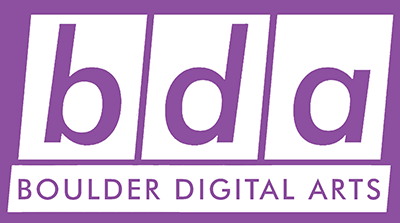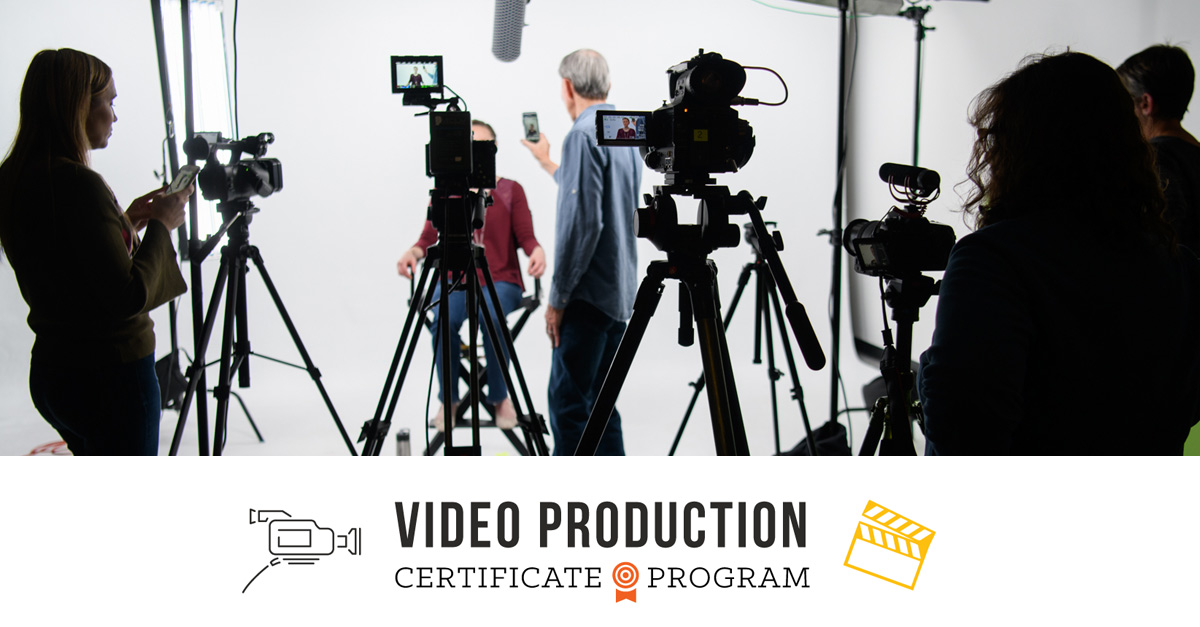Description
This program will next be held from November 18-23, at Niche Workspaces in Boulder! Reserve your space today!
This comprehensive, one-week certificate program held in-person in Boulder is designed to teach you practical skills, and get you up-to-speed using 4K and HD digital video cameras, DSLRs, lighting equipment and audio gear, enabling your creative vision. You’ll learn essentials like composition, depth of field, exposure tools, white balance, understanding color temperature, and camera menus, as well as professional lighting techniques, camera movement tools, and how to record clean audio.
Other topics covered are production workflow, the business side of video, shooting B-roll with the edit in mind, lighting, conducting great interviews, how to do a site survey, and so much more!
Schedule
Monday
9am – 10:30am: Video Camera Basics, Part 1
We’ll start by getting to know each other a bit then explore the strengths and weaknesses of different cameras for different jobs. After a very brief history of video, we’ll discuss lenses and learn about camera sensors-the pros and cons of various sizes. You’ll then learn about the four factors that determine depth of field and getting the “look” you desire.
10:45am – 12pm: Video Camera Basics, Part 2
After the break we’ll take you through the six steps in setting up a camera so you’re ready for a shoot. Using your camera’s menu, you’ll learn about setting the recording format and frame rate, the shutter speed, ISO, aperture and neutral density filter. We’ll explain the exposure triangle and the exposure rectangle. You’ll then have time to work on getting a proper white balance. We’ll get you up to speed on the basics without going into geek overload.
12pm – 1pm: Lunch Break
1pm – 2:30pm: Introduction to Lighting, Part 1
Since lighting for interviews and b-roll is vital for most non-fiction video productions, we’ll start the afternoon with a presentation on the ” Art and Science of Lighting.” The instructor will explain color temperature and discuss the most common types of professional lighting instruments being used today (LED’s, tungsten, fluorescent and HMI’s) and when to use them. We’ll talk about putting a basic lighting package together for different prices ranges and look at some cheaper hardware store lights too.
2:45pm – 5pm: Introduction to Lighting, Part 2
In the second half the instructor will demonstrate classic 3- and 4-point lighting techniques for an interview situation using both tungsten and daylight-balanced lights. He will show how to create different looks and moods by repositioning the key light and adjusting the fill and back light. He’ll also demonstrate how to use diffusion, C-stands, flags, gels and bounce cards to modify the light. You’ll then learn how to use a monitor with waveform and zebras, set up a background kit for interviews and how to properly light a green screen.
Tuesday
9am – 10:30am: Getting Great Interviews
Since interviews are the foundation for so many video projects we’ll discuss various techniques for getting quality results and then practice interviewing each other. We’ll talk about on-camera clothing, what to avoid and why, along with the importance of a powder kit and other practical tips to help interviewees look and sound their best.
10:45am – 12pm: Audio for Interviews You’ll learn about the tools needed for location audio recording, including wireless lavs, shotgun mics, boom poles, hand mics, external recorders, mixers and cables. We’ll go over when to use mic or line levels and the different methods of recording audio on a DSLR. You’ll get practice attaching a lav properly and using a shotgun mic on a boom pole.
12pm – 1pm: Lunch Break
1pm – 2:30pm: Audio for 1-Camera Interviews
In this session we’ll practice location audio recording for video by setting up an interior interview scenario, using the lighting style we learned on Monday. The instructor will mic the interviewee, demonstrating proper mic placement techniques using a wireless lav and a boom mic. We’ll also discuss going directly into your camera vs. through a mixer.
2:45pm – 5pm: Team Interview Lighting & Audio
Now it’s your turn to light and set up audio for an interview! We’ll break into teams where everyone will get a chance to be the “DP” and design the lighting set-up. You’ll rotate through the crew positions on your team to get experience doing the different jobs. If you have them, throughout this last session you will be using your own camera and tripod to build up hands-on time with your gear.
Wednesday
9am – 10:30am: The Video Production Workflow
You’ll learn the six “Ps” of professional video production workflow. We’ll walk through a sample project starting with the Proposal, then Pre-Production, Production, Post- Production and Payment. There will be an emphasis on Pre-Production since it involves so many things: the script, shot list, location scouting, scheduling, detailed budgeting and prepping for the shoot. The class exercise will be to conduct a site survey.
10:45am – 12pm: Shooting an Outdoor Interview
Since a videographer is often required to shoot an interview outside, the instructor will demonstrate techniques to help you control the sun and shadows on your talent to achieve good-looking results. You’ll get experience using a large silk, bounce cards, reflectors and daylight-balanced lights. Outdoor audio recording will also be discussed. Then it’s your turn to set up your camera (or the instructors, if you don’t have your own) and properly expose for an outdoor interview situation. Next, we’ll go back inside to the lobby and learn how to manage daylight for interior shots. You’ll get more hands-on experience as you set up for an interview and the instructor demonstrates various ways to make daylight work for you instead of against you.
12pm – 1pm: Lunch Break
1pm – 2:30 pm: Shooting a Sequence
We’ll watch a short video and analyze the various shots it uses to tell the story. You’ll learn how to “shoot for the edit” and build a sequence when shooting b-roll. We will then discuss your afternoon assignment and strategies for creating a b-roll sequence or story on your own.
2:45pm – 5pm: Assignment: Shoot a Sequence Outside
Your assignment will be to use what you have learned so far to create a visual sequence or sequences at a nearby outdoor mall or park. You will get to use your own camera gear if you have it in a real-world situation. When you have completed the assignment, we will regroup to discuss your experience and look at some of the footage.
Thursday
9am – 10:30am: The Business Side of Video
Whether you’re going to work freelance, as part of a production company, or in a department within a larger corporation, you need to know about the business side of video. Marketing your services, putting together job estimates, keeping track of your expenses, buying insurance, drawing up contracts, paying taxes and getting paid, along with many other details. Learning about the business side of video production will help you to make a living doing what you love to do.
10:45am – 12pm: Shooting With a DSLR
The DSLR has been called a “disruptive” technology because it came out of nowhere to rock the video production industry. In this session we’ll explore the most popular DSLRs in use today and discuss the pros and cons of using this type of camera. We’ll talk about lenses, rigs, cages and audio recording options then give you hands-on time with several different cameras and rigs.
12pm – 1pm: Lunch Break 1pm – 2:30 pm: Camera Movement Tools, Part I
In this session, the instructor will give a presentation about different camera movement tools that are used to create motion and enhance video footage, adding interest and production value. You’ll get hands-on practice with dolly and slider shots, as well as practice time with handheld gimbals.
2:45pm – 5pm: Camera Movement Tools, Part 2
Now we’ll put your practice to the test. We’ll design a short action scene that will utilize a dolly shot, a gimbal shot, tripod and slider shots. We’ll create a multi-cam scenario and rotate positions so everyone will get experience using the different camera movement equipment as well as being the director and slate op.
Friday
9am – 10am: Q & A/Review
In the morning session you’ll have a chance to ask questions about anything covered so far. We’ll then have an opportunity for “show and tell” from fellow classmates, looking at videos and analyzing them for shot usage and style.
10:15am – 12pm: Designing a Marketing/Promo Video
Now we’ll begin planning for the afternoon exercise: shooting a formal interview with a guest client- something they could use for a marketing or promo video. We’ll research our guest client online and put together a list of suitable questions for the interview. You’ll help plan a shot list for possible b-roll footage if it was a full video production. We’ll then pick our interview location and begin the set-up.
12pm – 1pm: Lunch Break
1pm – 3pm: Shooting a Promo Video
We’ll complete our set-up for the interview and get ready. You will participate in all phases of the production: lighting, camera placement and movement, audio recording and operating the camera. We’ll create multiple camera shots so you can practice using your own cameras in a multi-cam situation. You’ll get to put all the techniques you’ve learned during the week into action!
3:15pm – 5pm: Certificates & Wrap-Up
The client interview is in the can and now it’s wrap time! You will then be awarded your Certificate and enjoy a well-deserved break to reminisce about the week. Congratulations! You made it!





Galen Nathanson
September 10, 2025 - 5:31 PMHi Matt- Those dates were for last year’s program; I don’t have anything scheduled for that yet this year, sorry.
Matt Kocourek
September 10, 2025 - 4:46 PMHello, can you please confirm the dates for this course? The description shows November 18-23, which is a Tuesday-Sunday. Thanks,
Carlyn Pudwill
September 25, 2024 - 6:07 PMHello! I am reaching out as an employee with Colorado Parks & Wildlife education team, where I have the honor of making educational videos about our special landscape. I am eager to learn more about this program with you all and very keen to take the course. Did this in-person course have specific dates? Thank you!
Sara Clauser
September 19, 2024 - 9:04 PMHello, I'm interested in sending an employee to this certification. What are the dates that it is being offered?